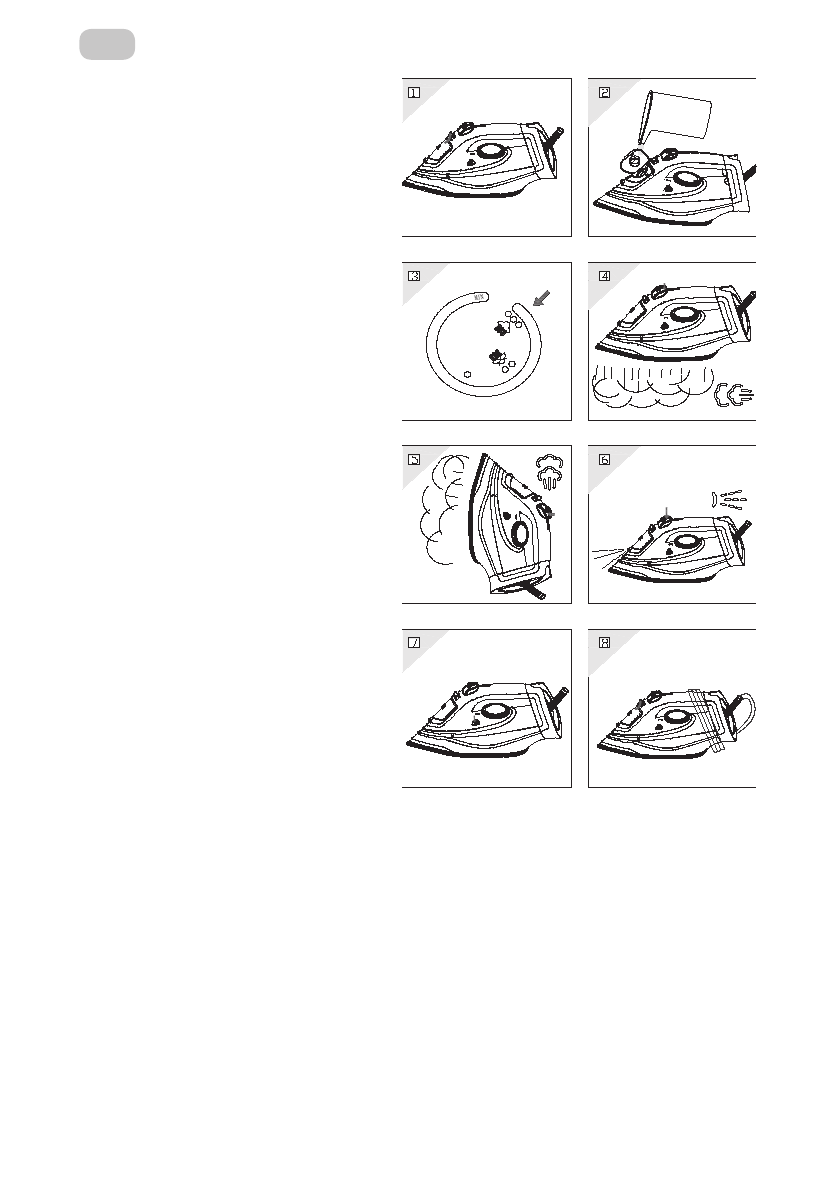Утюги Ardesto IR-C2230 - инструкция пользователя по применению, эксплуатации и установке на русском языке. Мы надеемся, она поможет вам решить возникшие у вас вопросы при эксплуатации техники.
Если остались вопросы, задайте их в комментариях после инструкции.
"Загружаем инструкцию", означает, что нужно подождать пока файл загрузится и можно будет его читать онлайн. Некоторые инструкции очень большие и время их появления зависит от вашей скорости интернета.

10
UA
- Завжди зберігайте праску у
вертикальному положенні.
ПОРАДИ ДЛЯ ЕФЕКТИВНОГО
ПРАСУВАННЯ
Використовуйте найнижчу тем-
пературу для прасування тка-
нин із декором (блискітками,
вишивкою, рельєфом тощо).
Якщо тканини змішані (напри-
клад, 40 % бавовни, 60 % син-
тетики), установіть ручку тер-
морегулятора на прасування
тканини, яка вимагає нижчої
температури.
Якщо ви не знаєте склад тка-
нини, можете визначити не-
обхідну температуру шляхом
тестування температури на не-
помітній ділянці тканини. По-
чинайте з низької температури
й збільшуйте її поступово до
досягнення ідеальної темпера-
тури.
Ніколи не прасуйте місця зі
слідами поту або іншими за-
брудненнями: висока темпера-
тура лише закріпить плями на
тканині й зробить їх важкими
для виведення.
Прасуючи без пари, використовуйте помірний температурний режим,
щоб уникнути появи жовтих плям.
Щоб запобігти появі блискучих плям на виробах із шовку, вовни або
синтетики, прасуйте їх навиворіт.
Щоб запобігти появі блискучих плям на вельветових виробах, прасуйте
їх в одному напрямку (у напрямку волокна) і не тисніть на праску.
Що більше завантажена пральна машина, то більш м’ятим буде одяг. Це
5
-
Always put the iron away in a vertical position.
ADVICE FOR GOOD IRONING
We recommend using the lowest temperatures with fabrics that have unusual finishes
(sequins, embroidery, flush, etc.).
If the fabric is mixed (e.g. 40% cotton 60% synthetics), set the thermostat to the
temperature of the fibre requiring the lower temperature.
If you don’t know the composition of the fabric, determine the suitable temperature
by testing on a hidden corner of the garment. Start with a low temperature and
increase it gradually until it reaches the ideal temperature.
Never iron areas with traces of perspiration or other marks: the heat of the plate fixes
the stains on the fabric, making them irremovable.
The size is more effective if you use a dry iron at a moderate temperature: excess
heat scorches it with the risk of forming a yellow mark.
To avoid marking silk, woolen or synthetic garments shiny, iron them inside out.
To avoid marking velvet garments shiny, iron in one direction (following the fibre)
and do not press down on the iron.
The heavier the washing machine is loaded, the more garments come out creased.
This also happens when the spin drying revolutions are very high.
Many fabrics are easier to iron if they are not completely dry.
For example, silk should always be ironed damp.
5
-
Always put the iron away in a vertical position.
ADVICE FOR GOOD IRONING
We recommend using the lowest temperatures with fabrics that have unusual finishes
(sequins, embroidery, flush, etc.).
If the fabric is mixed (e.g. 40% cotton 60% synthetics), set the thermostat to the
temperature of the fibre requiring the lower temperature.
If you don’t know the composition of the fabric, determine the suitable temperature
by testing on a hidden corner of the garment. Start with a low temperature and
increase it gradually until it reaches the ideal temperature.
Never iron areas with traces of perspiration or other marks: the heat of the plate fixes
the stains on the fabric, making them irremovable.
The size is more effective if you use a dry iron at a moderate temperature: excess
heat scorches it with the risk of forming a yellow mark.
To avoid marking silk, woolen or synthetic garments shiny, iron them inside out.
To avoid marking velvet garments shiny, iron in one direction (following the fibre)
and do not press down on the iron.
The heavier the washing machine is loaded, the more garments come out creased.
This also happens when the spin drying revolutions are very high.
Many fabrics are easier to iron if they are not completely dry.
For example, silk should always be ironed damp.
Характеристики
Остались вопросы?Не нашли свой ответ в руководстве или возникли другие проблемы? Задайте свой вопрос в форме ниже с подробным описанием вашей ситуации, чтобы другие люди и специалисты смогли дать на него ответ. Если вы знаете как решить проблему другого человека, пожалуйста, подскажите ему :)
























